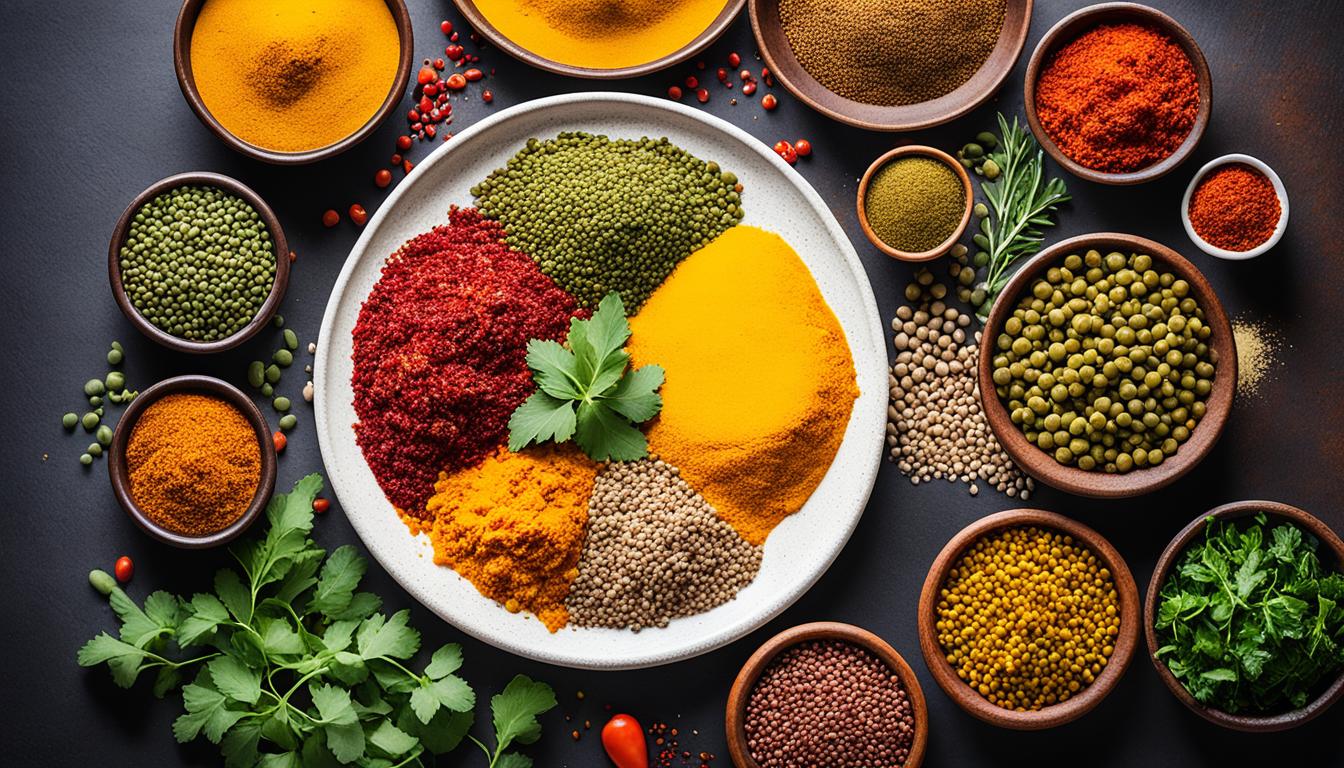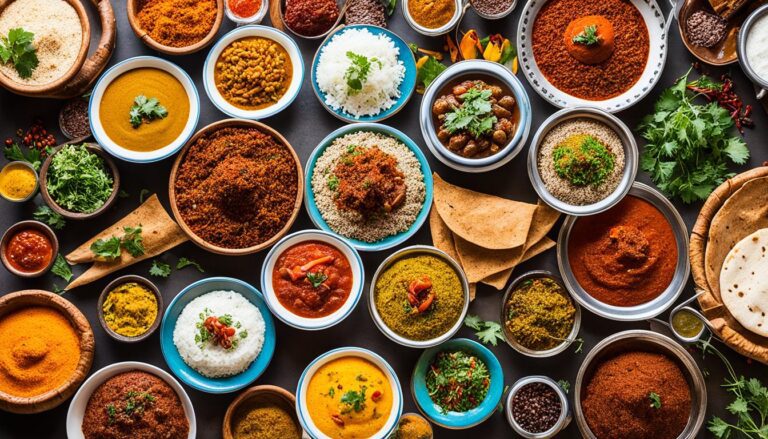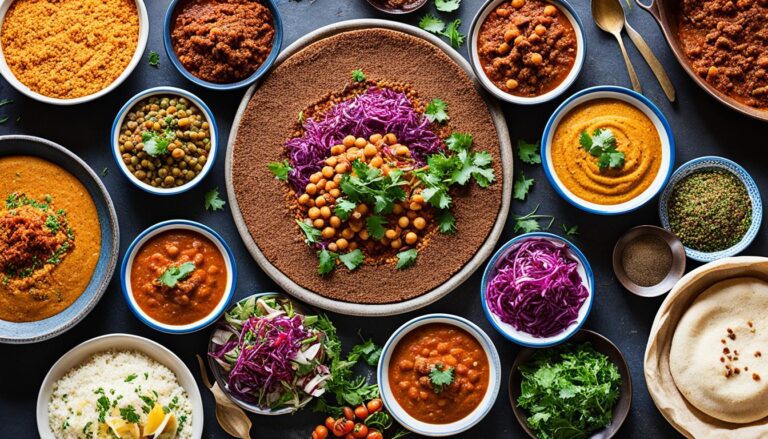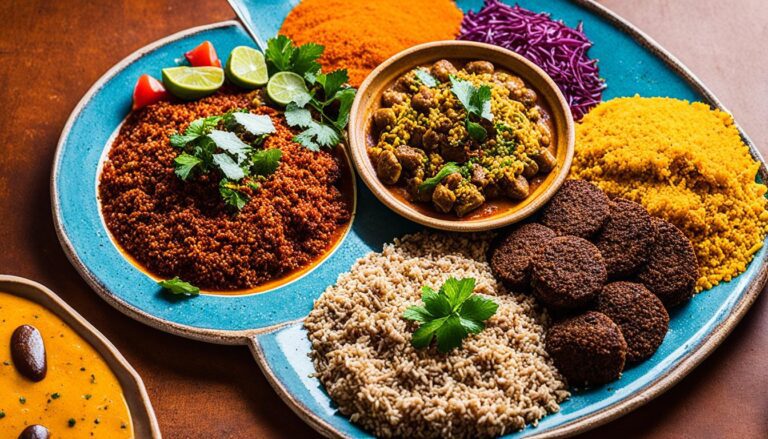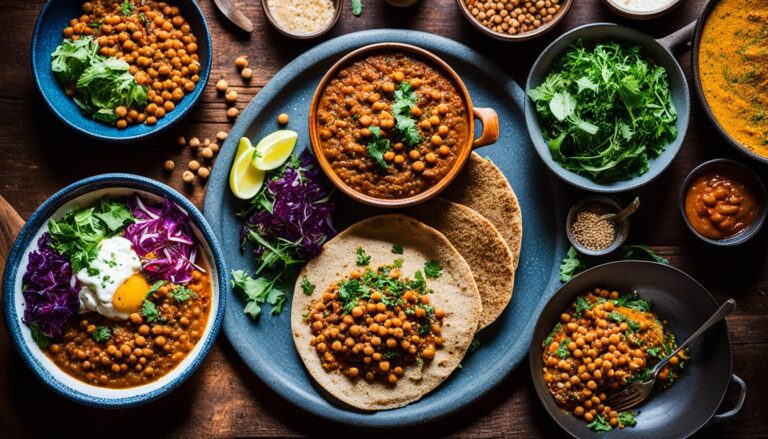What Does Ethiopian Food Consist Of?
Have you ever wondered what makes Ethiopian cuisine so enticing and full of flavors? From robust stews and unique spices to the famous injera bread, Ethiopian food has captured the attention of food enthusiasts around the world. But what exactly does Ethiopian food consist of, and what makes it stand out from other culinary traditions?
Join us as we embark on a culinary adventure, exploring the vibrant flavors and diverse ingredients that define Ethiopian cuisine. From staple ingredients that form the foundation of many dishes to the importance of injera bread and the flavorful stews that tantalize the taste buds, we’ll uncover the secrets behind this captivating gastronomic experience.
Key Takeaways:
- Ethiopian cuisine is renowned for its robust stews, diverse spices, and unique flavors.
- Injera bread, made from teff flour, serves as a versatile and essential component in Ethiopian meals.
- Staple ingredients like grains, legumes, and vegetables form the foundation of many Ethiopian dishes.
- Berbere and mitmita are two popular spice blends that contribute to the distinct taste profile of Ethiopian cuisine.
- Popular Ethiopian dishes include doro wat, kitfo, and shiro, each offering a unique taste of the country’s culinary heritage.
Staple Ingredients of Ethiopian Cuisine
Ethiopian cuisine is renowned for its flavorful and diverse dishes. To understand the essence of this vibrant culinary tradition, we must explore the staple ingredients that form the foundation of Ethiopian cuisine.
Grains: Various grains play a crucial role in Ethiopian cooking. Teff, a tiny grain indigenous to Ethiopia, is the key ingredient for making the famous injera bread. Barley and corn are also commonly used in traditional dishes, adding a hearty and wholesome element to the cuisine.
Legumes: Lentils and chickpeas are staples in Ethiopian cuisine, providing a valuable source of protein and adding a satisfying texture to dishes. These legumes are deliciously seasoned and used in stews and salads, showcasing the versatility of Ethiopian cooking.
Vegetables: A variety of vegetables are incorporated into Ethiopian dishes, contributing to their vibrant colors and flavors. Cabbage, carrots, and potatoes are frequently used in stews, creating a robust and satisfying meal. These vegetables not only enhance the taste but also provide essential nutrients.
To truly appreciate the rich flavors of Ethiopian cuisine, it is essential to understand and embrace these staple ingredients. By combining grains, legumes, and vegetables, Ethiopian chefs continue to create mouthwatering dishes that captivate the palate and celebrate the country’s culinary heritage.
The Importance of Injera Bread
One cannot talk about Ethiopian cuisine without mentioning injera, a traditional sourdough bread that serves as a versatile and fundamental element in Ethiopian meals. Made from teff flour, injera is a spongy and slightly tangy bread that is used to scoop up the various stews, acting both as a utensil and a filling component of the meal.
The Versatility of Injera
Injera plays a central role in Ethiopian food culture, and its unique characteristics make it a beloved and essential part of the cuisine. Its spongy texture and tangy taste create a delightful contrast when paired with the rich flavors of Ethiopian stews.
One of the remarkable qualities of injera is its ability to soak up sauces and juices, enhancing the overall eating experience. It acts as a perfect vessel for scooping up the flavorful Ethiopian stews, such as doro wat or kitfo, ensuring every bite is full of deliciousness.
Furthermore, injera can also be enjoyed as a standalone dish. Its sourdough nature and tangy taste make it a tasty snack on its own or the perfect base for toppings like vegetables or cheese, offering a diverse range of culinary possibilities.
The Tradition of Injera
Injera holds deep cultural significance in Ethiopia, where it is prepared and enjoyed in homes and restaurants alike. The process of making injera is a cherished tradition that involves fermenting the batter for several days, resulting in a distinct sour flavor.
It is fascinating to witness the skillful preparation of injera, as the batter is poured onto a large griddle and cooked over an open flame. The circular shape and porous texture are characteristic of injera, making it easily recognizable and deeply connected to Ethiopian culinary heritage.
Whether dining in an Ethiopian restaurant or trying your hand at cooking Ethiopian cuisine at home, the experience is incomplete without the presence of injera. Its role as an essential part of Ethiopian meals cannot be overstated, and its unique taste and texture add a special touch to every bite.
Flavorful Ethiopian Stews and Dishes
Ethiopian cuisine is known for its delectable and robust stews, referred to as wats. These flavorful stews can be prepared with a variety of ingredients, catering to both vegetarian and meat lovers alike. Whether you prefer a hearty vegetable-based stew or a savory meat-filled dish, Ethiopian cuisine has something to satisfy every palate.
The secret to the irresistible taste of Ethiopian stews lies in the skillful use of spices. The combination of aromatic herbs and unique spice blends, such as berbere and mitmita, elevates the flavors to new heights. These carefully crafted spice blends infuse the stews with layers of complexity, adding a depth of flavor that is both tantalizing and unforgettable.
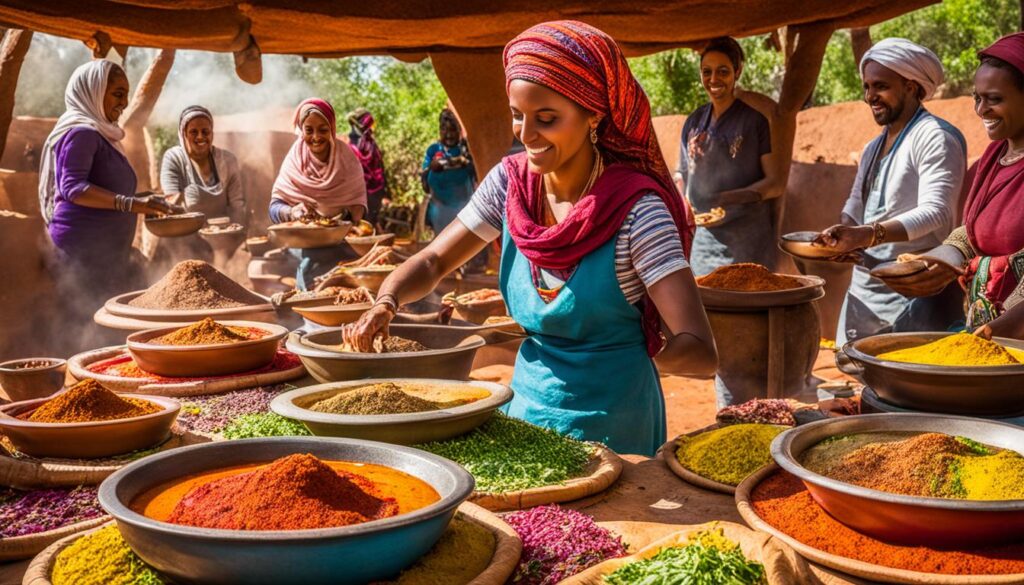
The berbere spice blend, a cornerstone of Ethiopian cuisine, is made from chili peppers, garlic, ginger, and a medley of aromatic herbs. Its fiery and distinct flavor profile adds a bold kick to the stews, creating a harmonious balance of heat and spice.
Another popular spice blend, mitmita, offers a vibrant and flavorful twist to Ethiopian dishes. Packed with chili peppers, cardamom, and other aromatic spices, mitmita provides a spicy and tangy flavor that complements the rich and hearty stews perfectly.
Whether you savor the vegetarian options or indulge in the meaty delights, Ethiopian stews are a celebration of bold flavors and exquisite spices. These mouthwatering dishes are best enjoyed with injera, the traditional Ethiopian bread that complements the stews, creating an unmatched culinary experience.
Exploration of Traditional Ethiopian Spices
Ethiopian cuisine is renowned for its unique and vibrant flavors, which are attributed to the wonderful array of spices used in their dishes. These spices not only enhance the taste profile but also showcase the rich culinary heritage of Ethiopia.
One of the most famous spice blends in Ethiopian cuisine is berbere. This fiery blend combines chili peppers, garlic, ginger, and various aromatic herbs, creating a complex and bold flavor. Berbere adds a delightful kick to dishes, infusing them with a tantalizing heat that pleases spice enthusiasts.
Mitmita is another popular spice blend that contributes to the distinct taste of Ethiopian food. Known for its vibrant and spicy nature, mitmita contains a combination of chilies, cardamom, cloves, and other aromatic spices. This unique blend adds a burst of flavor to dishes, creating a truly memorable dining experience.
These traditional Ethiopian spice combinations set the cuisine apart from others, creating an explosion of unique flavors that cannot be replicated. The skillful use of berbere and mitmita by Ethiopian chefs showcases their expertise in crafting dishes that are both satisfying and extraordinary.
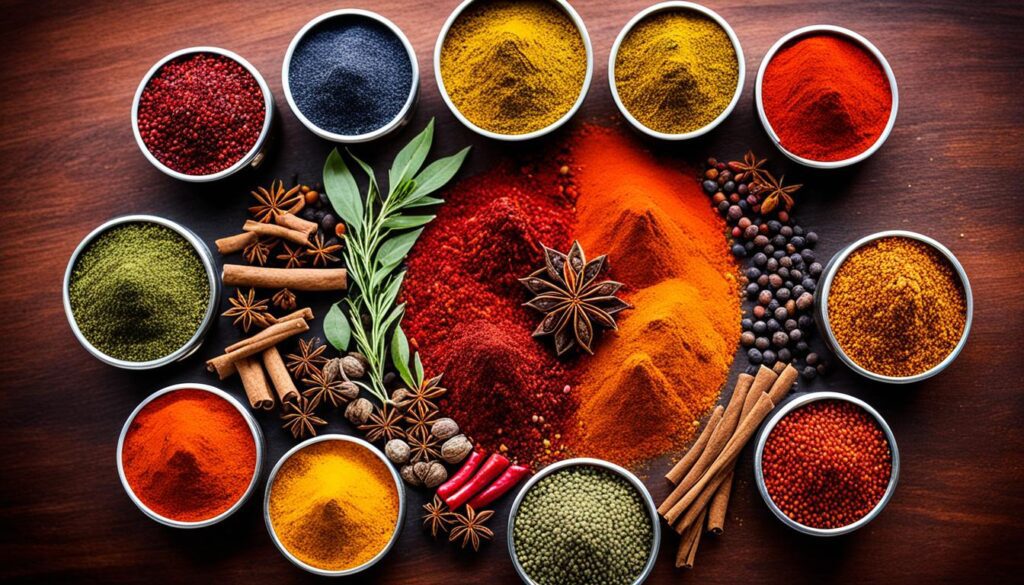
As you can see in the image above, the vibrant colors of Ethiopian spices mirror the incredible flavors they bring to each dish. The visually appealing assortment of spices on display is a testament to the rich culinary tradition of Ethiopia.
Popular Ethiopian Dishes and Specialties
Ethiopian cuisine offers a diverse array of popular dishes that are sure to satisfy your taste buds. Let’s explore some of the most beloved Ethiopian specialties:
Doro Wat
Doro wat is a mouthwatering chicken stew that is considered the national dish of Ethiopia. Made with tender chicken simmered in a flavorful sauce rich in spices, onions, garlic, and berbere (a traditional Ethiopian spice blend), it is a true culinary delight. The aromatic aroma of doro wat will entice your senses, and the tender chicken will melt in your mouth.
Kitfo
Another popular Ethiopian dish is kitfo, a spiced minced meat dish that is often enjoyed raw or lightly cooked. Typically made with ground beef or lamb, kitfo is seasoned with mitmita (a fiery spice blend) and served with injera bread. The combination of tender meat and bold flavors makes kitfo a favorite among locals and visitors alike.
Shiro
Shiro is a flavorful chickpea or lentil stew that is commonly consumed in Ethiopia. It is made by grinding roasted chickpeas or lentils into a flour-like consistency, which is then cooked with onions, garlic, and spices. The result is a thick and hearty stew that is bursting with aromatic flavors. Shiro is often enjoyed with injera, adding an additional layer of texture to the meal.
These popular Ethiopian dishes offer a glimpse into the rich culinary heritage of the country. The combination of aromatic spices, tender meats, and hearty stews is sure to captivate your taste buds and provide a truly memorable dining experience.
Conclusion
Ethiopian cuisine is a tantalizing culinary adventure that combines a captivating blend of flavors, textures, and spices. From the spongy injera bread to the aromatic stews and vibrant spice blends, every bite offers a gastronomic journey filled with delight. Whether you are an adventurous eater or simply looking to explore new flavors, Ethiopian cuisine is definitely worth discovering.
One of the highlights of Ethiopian food is the staple injera bread, a sourdough delight that serves as both a utensil and an integral part of the meal. You’ll find yourself enchanted by how its spongy texture and slight tanginess perfectly complement the robust stews and dishes.
Speaking of stews, Ethiopian cuisine is known for its flavorful wats, which can be made with vegetarian or meat-based ingredients. The secret lies in the unique spice blends like berbere and mitmita, which infuse the stews with layers of complex flavors that will leave your taste buds craving for more.
With popular dishes like doro wat, a mouthwatering chicken stew, kitfo, a spiced minced meat dish, and shiro, a flavorful chickpea or lentil stew, Ethiopian cuisine offers a rich assortment of options to indulge in. Paired with the traditional injera bread, these dishes showcase the rich culinary heritage of Ethiopia.
So, if you’re ready to embark on a culinary journey like no other, delve into the vibrant world of Ethiopian cuisine. Prepare to be mesmerized by the diverse flavors, the aromatic spices, and the unique dining experience that Ethiopian food brings to the table. It’s an adventure that will broaden your culinary horizons and leave you craving for more Ethiopian delights.

